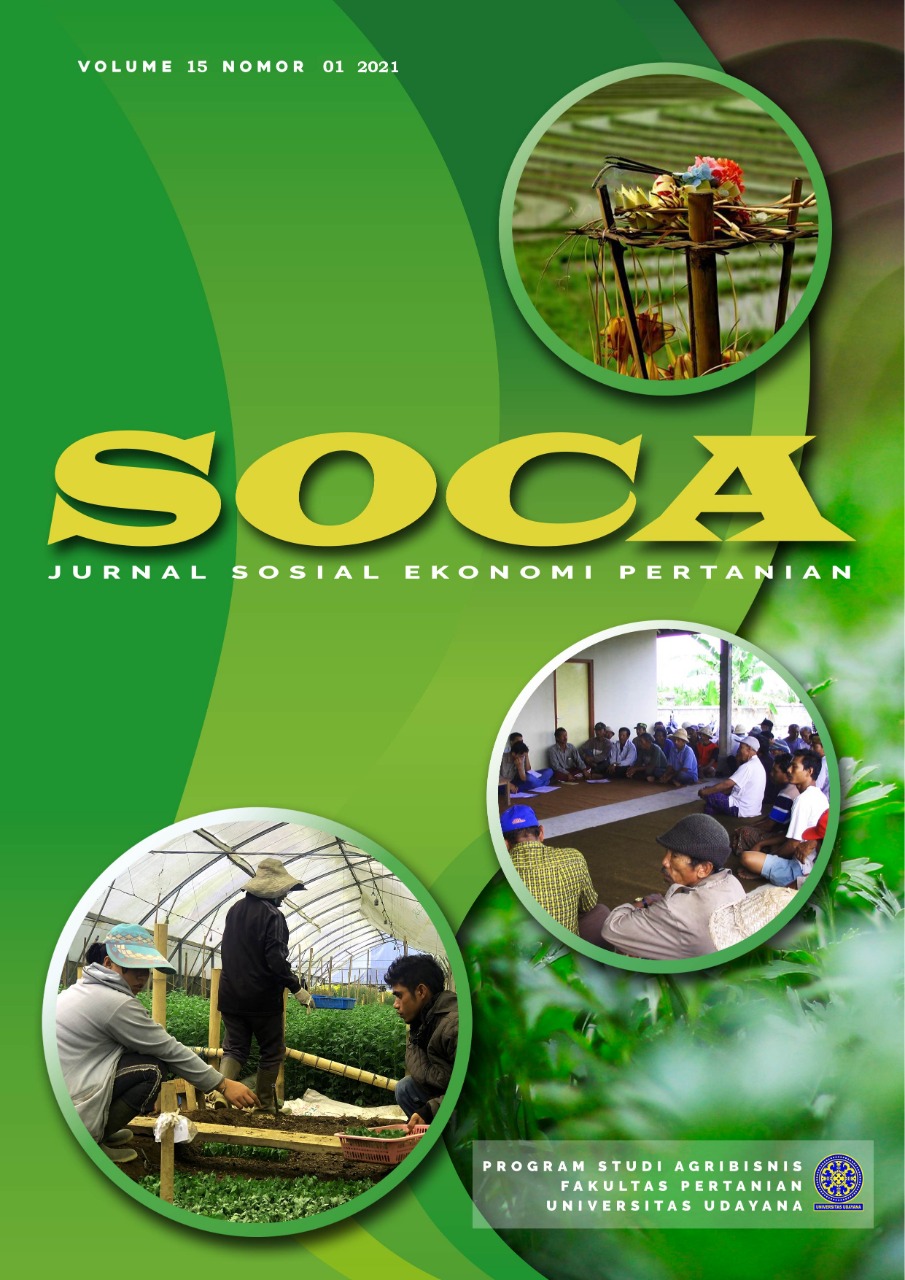Potential Development of Balinese Water-Control System (Subak) Based Agro-Tourism in the World Cultural Heritage Site of Catur Angga Batukaru
Abstract
One of the cultural world heritage sites in the cultural landscape in Bali province is the area of Catur Angga Batukaru. The aim of this research is to unearth the potentials which could be developed from the Balinese water-control systems (Subak) in the area of Catur Angga Batukaru. The results of the research show that, at present, there has been 20 water-control systems recorded in the area of Catur Angga Batukaru. The lines go through 19 water-control systems. The kind of tourism which could be developed included: (i) sightseeing tourism, where the tourist walk through the area and enjoy the sightseeing and views of the rice terraces together with some other plantation views in the area. (ii) Spiritual tourism, which located at Tamba Waras Temple, where people come to pray for an abundant of health or a recovery of those who are suffering some medical conditions, and at Muncaksari Temple, where people could come to pray for those who wish to be successful in business and trading. (iii) Trekking tourism, which deemed much suitable for adventurous tourists. The trekking paths would be through some rice field area, plantation, and some river crossing by. The attractions available would include some sightseeing of the local farmers busy in the field, planting red rice, taking care of the irrigation system, working on the soil, planting seeds, cleaning up the plant, and harvesting by using some traditional tools used in the associated culture called “ane-ane”, and lastly, some view of traditional religious ceremony in the rice field area as well as around the water-control system (Subak). All things considered, these potential activities are considered needed to be developed further by the community such as through the water-control system society and the village cultural authorities to be assisted bythe local government training and consultation. Lately, the safari tour has been passing through the area as well. The spiritual tourism at the least has also been developing. However, these circumstances have not been well-organized both by the local authorities and the government in it.
Downloads
References
Anonim, 2010. Model Pengelolaan Kawasan Konservasi Berbasis Ekosistem, Rencana Penelitian Integratif (RPI), Tahun 2010 – 2014.
Anonim, 2013, Rencana Pengelolaan Lanskap Budaya Provinsi Bali, Direktorat Internalisasi Nilai dan Diplomasi Budaya, Direktorat Jenderal Kebudayaan, Kementerian Pendidikan dan Kebudayaan.
Fabianto dan Berhitu, 2014, Konsep Pengelolaan Wilayah Pesisir Secara Terpadu dan Berkelanjutan Yang Berbasis Masyarakat, Jurnal TEKNOLOGI, Volume11 Nomor2, 2014; 2054 – 2058.
Kusumadewi, 200, Kusumadewi, S., Sri H., Agus H., dan R. Wardoyo. 2006. Fuzzy Multi-Atribute Desicion Making (Fuzzy MADM). Graha Ilmu. Yogyakarta.
Liungkakoa, B. 2014. OBSERVASI DAN DESAIN OBJEK WISATA DI DESA GAMTALA KECAMATAN JAILOLO, http://agroekowisataco.blogspot.com/. Diakses tanggal 14 February 2019.
Rangkuti, F. 2008. Analisis SWOT:Teknik Membedah Kasus Bisnis. Penerbit PT Gramedia Pustaka Utama. Jakarta.
Yoeti, Oka, A. (2006) Pengantar Ilmu Pariwisata. Angkasa, Bandung.
Cooper, Fletcher, J., Gilbert, D., Shepherd, R., Wanhill,S., 1998, Tourism Principles and Practice, 90 Tottenham Court Road, London.
Sumarmi, S. Bachri, E. Kurmiawati. 2018. Pendampingan Pemetaan Potensi Pertanian Lokal Dan Pengelolaannya Dalam Mendukung Agro Ekowisata Kecamatan Kandangan Kabupaten Kediri. Jurnal Praksis Dan Dedikasi Sosial 1(2):125-134.
Salamanca, A.M., A. Nugroho, M. Osbeck, S. Bharwani, N. Dwisasanti. 2015. Managing A Living Cultural Landscape: Bali’s Subaks And The Unesco World Heritage Site. Stockholm Environment Institute, Thailand.
Sahara, F. N. A., M. Iqbal, B. Sanawiri. 2016. Analisis Motivasi Berkunjung Wisatawan Dan Tingkat Pengetahuan Wisatawan. Tentang Produk Industri Kreatif Sektor Kerajinan (Studi Pada Wisatawan Domestik di Kota Batu, Jawa Timur). Jurnal Administrasi Bisnis 35(2):146-154.
Richardy, M.A. 2014. Analisis Kesesuaian Permintaan (Demand) Wisatawan Dan Penawaran (Supply) Obyek Wisata Pantai Walengkabola. Jurnal Teknik PWK 1(1):519-531.
Budiarti, T., Suwarto, I. Muflikhati. 2013. Pengembangan Agrowisata Berbasis Masyarakat pada Usahatani Terpadu guna Meningkatkan Kesejahteraan Petani dan Keberlanjutan Sistem Pertanian. Jurnal Ilmu Pertanian Indonesia 18(3):200-207.
Dwiridotjahjono, J., A. Z. Arifin, P. E. Sasongko, Maroeto, W. Santoso. 2017. Strategi Pengembangan Agroekowisata Kopi Rakyat di Kabupaten Pasuruan. Malkas Media, Indonesia.
Diarta, I K. S., I M. Sarjana. 2018. Strategi Pengembangan Subak Padanggalak sebagai Daya Tarik Wisata di Kota Denpasar Bali. Media Konservasi 23(3):281-292.
Wendri, I G. M. 2016. Kajian Motivasi: Penawaran Pariwisata Spiritual Bali ke Depan. Jurnal Sosial dan Humaniora, 6(1):66-77.
Claudia, H. 2018. Motivasi Wisatawan Mancanegara Dalam Kegiatan Trekking Di Bukit Lawang, Kabupaten Langkat Sumatera Utara. Jurnal Khasanah Ilmu (9)2:28-40.













